Trying to decide whether it’s best to purchase a sublimation-specific printer or convert an inkjet printer using sublimation ink? We compare both options in this sublimation printer comparison!
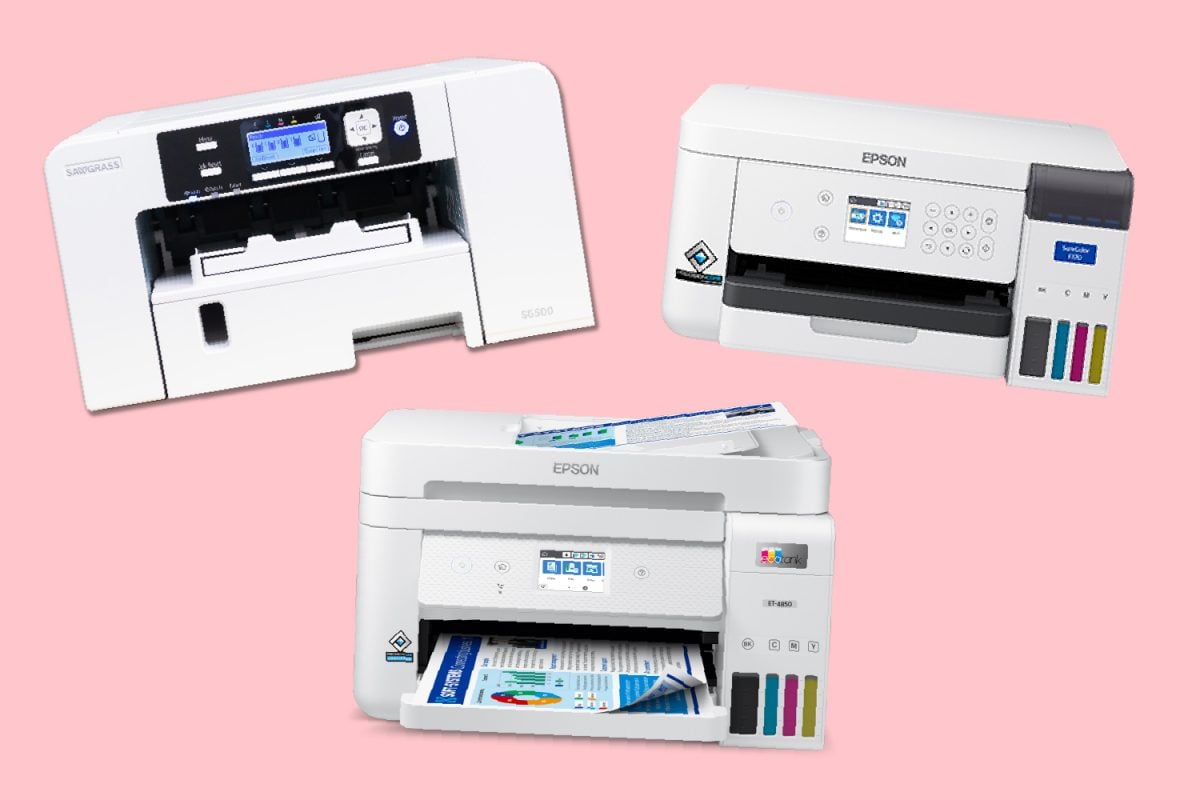
Are you ready to dive into sublimation printing? While sublimation printing has been around for quite some time, it’s become more accessible and popular with everyday crafters. What used to be a professional printing option is now something you can have access to in your own home. Pretty cool!
Before you can start sublimation printing, you’ll need to decide what kind of printer you will use. You can purchase a sublimation-specific printer, which is often more geared toward professional printing, or buy a standard inkjet printer that can be converted into a sublimation printer.
Today I’ll be walking you through the pros and cons for each so you can make the best choice for your crafting needs.
Want to learn more about sublimation printing? You can check out all of the posts in my sublimation printing series here (this list is updated as more posts are added):
- The Ultimate Guide to Sublimation Printing & Crafting
- What’s the Difference Between Sublimation, Cricut Infusible Ink, and HTV?
- How to Convert a Printer for Sublimation
- ICC Profiles & Color Management for Beginners
- Sublimation Software: What’s Best for Your Needs?
- The Best Sublimation Blanks and Substrates for Crafters
- Must-Have Sublimation Supplies and Tools
- Sublimation Paper Comparison
- Heat Press Machine Comparison for Sublimation Crafters
- Using Sublimation Prints with the Cricut Mug Press
- The Beginner’s Guide to Sublimation on Ceramic
- Troubleshooting Sublimation Printing
- Sublimation Cheat Sheets for Time, Temperature, Pressure & More!
Join our Sublimation Made Simple Facebook group for tips, tricks, support, and resources!
Sublimation Printer Options
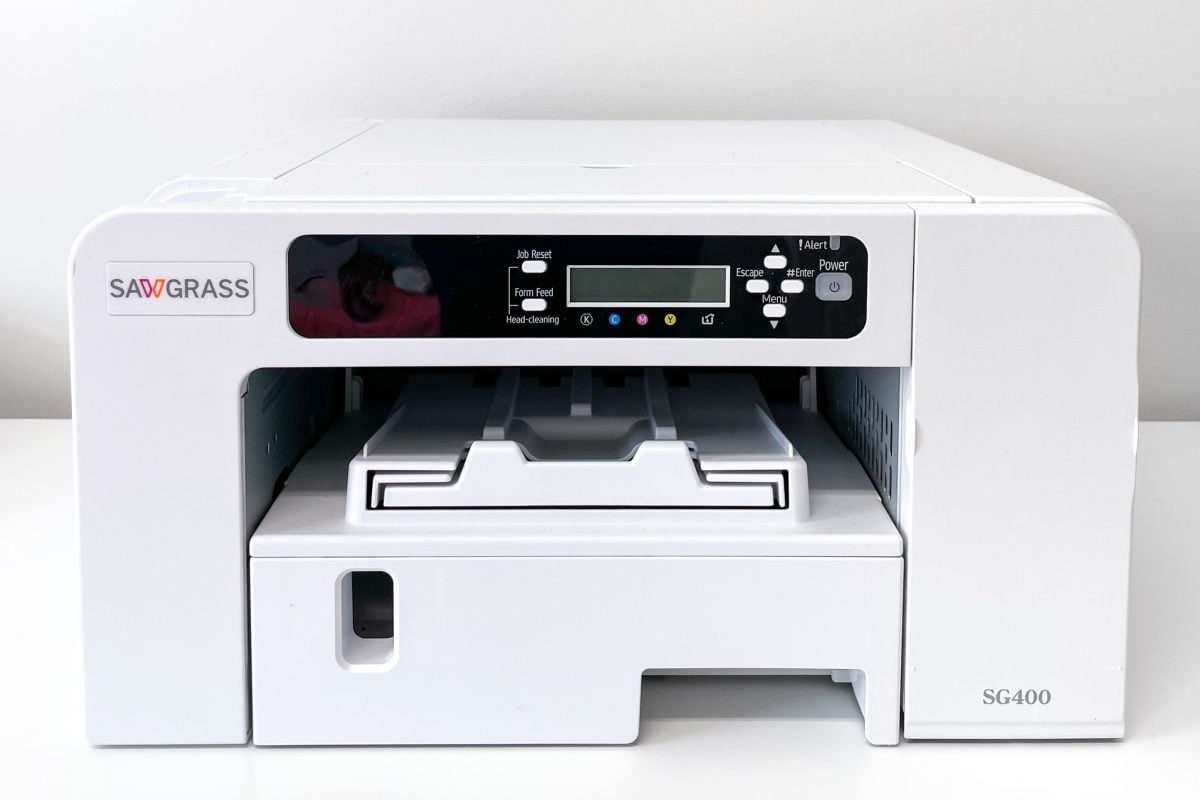
There are a lot of sublimation printer options out there, but I want to focus on printers that are the most accessible to the everyday crafter. I have personally used a Sawgrass printer (an older SG400 model), and there’s a newer Epson that’s also on my radar that I’ve listed here:
- Sawgrass SG500 (8.5″ x 11″ printing)
- Epson SureColor F170 (8.5″ x 11″ printing)
If you want a printer for larger images, the price increases dramatically. The Sawgrass SG1000 (11″ x 17″ printing, or larger if using the bypass tray) is about $1000 more than the SG500 for example.
I expect that printer manufacturers will start producing these smaller sublimation-specific printers as the market for these machines grows. Hopefully this will start to bring the price point down as well.
Sublimation Conversion Printer Options
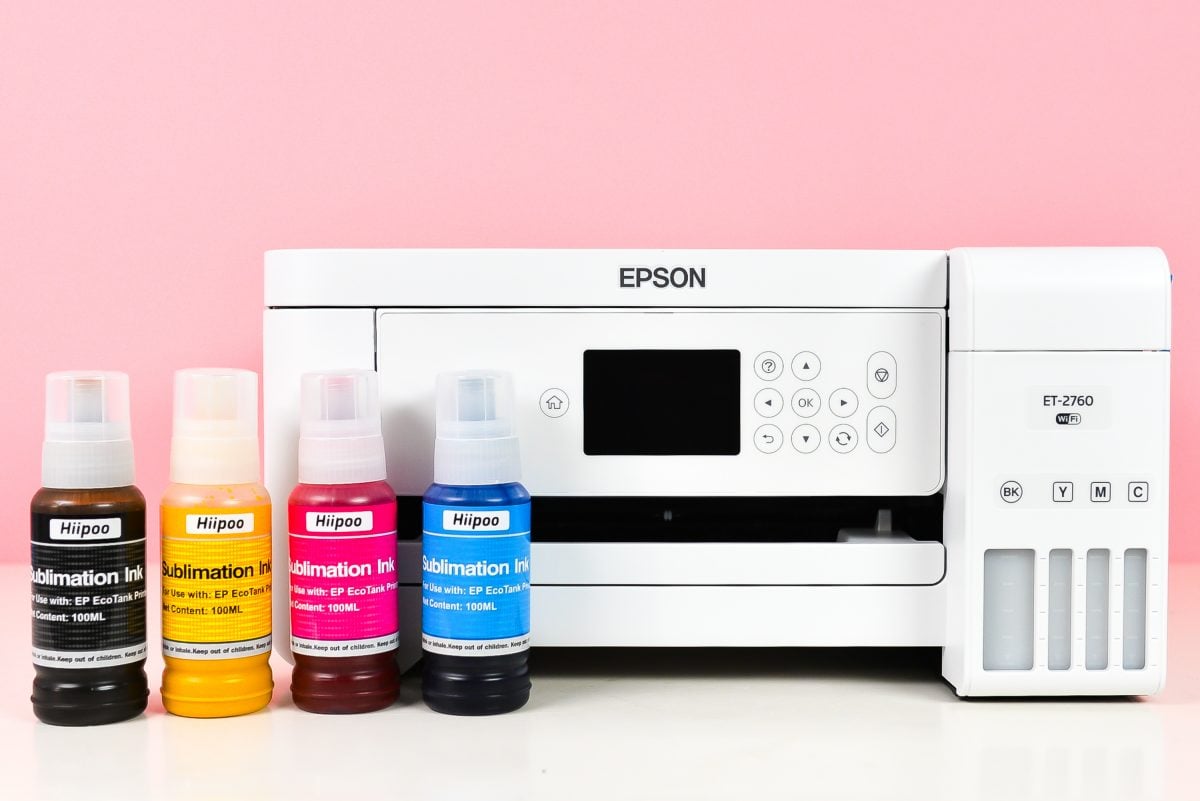
At the time of this post, Epson is the only company that makes a regular inkjet printer that can be converted. Any Epson EcoTank printer will work, as long as it has four colors (a few of the higher-end models have an additional gray reservoir, and this isn’t compatible with the sublimation inks on the market).
I swear, Epson has a new EcoTank printer out every week so direct links would be outdated quickly, so here are places you can find these printers:
- Epson EcoTank printers from Amazon
- Epson EcoTank printers from Target
- Epson EcoTank printers from Best Buy
Make sure you are purchasing an EcoTank printer—other Epson printers that use ink cartridges will not work.
Other inkjet printers, like those made by Canon or HP, have an ink heating element that makes them unable to be converted properly.
Learn all about how to Convert an Epson EcoTank Printer for Sublimation—the EASY Way!
Sublimation Printer Comparison
Now let’s take a look at the differences between a sublimation printer and a conversion!
Hardware and Ink Costs
Sublimation-Specific Printer:
Sublimation printers are generally the more expensive option. Currently, the Epson SureColor F170 is the least expensive option available, and it’ll run you around $399. Epson’s sublimation ink will run you about $24 a bottle for each color, and you can buy colors individually which is helpful if you use more of one color than others (often black).
The Sawgrass printers and ink are more expensive ($500 and up). It will also cost you $77 per color cartridge to replace the ink, and you can buy individual colors as well. You can use after-market ink cartridges found on sites such as Amazon, but Sawgrass doesn’t recommend using any non-Sawgrass inks as print performance may not be optimal, it will void your warranty with Sawgrass, and over time can cause damage to the printer. While more expensive, Sawgrass printers are the quality-standard, especially if you’re looking to turn your sublimation hobby into a business, so paying more might be worth it for you in the long run.
Converted EcoTank Printer:
Inkjet printers are much cheaper than the sublimation-specific printers (about half the price), which make them a popular option for any hobby crafter beginning their sublimation journey. Epson EcoTank printers can be found as low as $199, which makes them much more accessible for many crafters than the more expensive sublimation-specific printers.
Inks for converted printers are much cheaper too. You can get a pack of four inks for around $24. Problem is, in almost all cases you have to buy all four colors of ink at once instead of buying them individually as needed. My personal favorite ink is Printers Jack. Their sublimation paper works well, also. You’ll find many crafters use this brand, as their products are reliable and well-priced, plus they often have black ink available individually vs. within the pack.
Technical Support
Sublimation-Specific Printer
Let’s start with Sawgrass. You also can’t beat the customer support provided by Sawgrass and its distributors. If you have an issue with setup, you can call and have a live person walk you through the process (sometimes even remotely through your computer). They’re knowledgeable and willing to troubleshoot with you.
Because I don’t own the Epson F170, I can’t speak to their customer service, though I see no reason they wouldn’t help you out if you’re having issues!
Converted EcoTank Printer:
You won’t have any Epson support with a converted inkjet printer because the printer is not meant for sublimation. Once you convert it, you void the warranty and support isn’t available. It would be like converting your Toyota Corolla into a boat and then wondering why Toyota technicians won’t work on it.
Support groups such as my Sublimation Made Simple Facebook group can help if you’re struggling! There are lots of people with real-life experience in these sorts of groups and you can usually find help quickly and easily.
Color Management
Sublimation-Specific Printer
Color management can be so tricky…but not if you have a sublimation-specific printer! Color management is built into the printer so there’s no need to install or fumble with color profiles or other color management. You should have gorgeous, true-to-color prints straight out of the box. And if you’re struggling, Sawgrass or Epson support should be able to help. This is one of the biggest benefits, in my opinion, to spending more on a sublimation-specific printer.
Converted EcoTank Printer:
Color management on a converted printer, however, can be a struggle. Some folks have great color withotut making any tweaks and others (*raises my own hand*) struggle to get correct colors. Often, you’ll need to install an ICC profile on your printer to help manage the color. Even then, you may still see different colors based on your substrate/blank, the humidity in your craft room, the age of your ink, and more. Depending on your set-up, you may find yourself doing a lot of testing to get your prints to look the best.
Software
Sublimation-Specific Printer
With a Sawgrass printer, you have access to its free design software, Creative Studio. The program comes with sublimation templates for many popular blanks/substrates. It’s simple to design or upload an image and know you’re getting the sizing just right. No guessing or other design programs needed! You can always use outside programs if you’d like, as well.
Epson’s sublimation printer does NOT have a built-in software like this, so it’s more like the EcoTank below.
Converted EcoTank Printer:
While converted printers don’t come with specific design software, you can truly use whatever program you are most comfortable with. I’d recommend Photoshop, Inkscape, Illustrator and even Cricut Design Space. Color management may be tricky within some of these, so I’ve written posts on how to use ICC profiles in both Design Space and Photoshop, if needed. Be on the lookout for posts on additional programs as well.
Maintenance
Sublimation-Specific Printer
A Sawgrass printer has very little (if any) maintenance—as long as you keep it turned on. The printer will perform a routine print head cleaning every so often. This helps your printer from getting clogged.
One thing to note, however: if you don’t use your printer very often, you may end up wasting more ink through the cleaning cycles than you actually use to print. This can be very costly (especially if you’re using brand name inks). This may be something you’ll want to consider before making your printer decision.
An Epson sublimation printer needs to have its printer heads cleaned manually, just like a converted printer. You can learn more in my post Sublimation Printer Maintenance for Converted Printers.
Converted EcoTank Printer:
Unlike a Sawgrass printer, you will need to manually clean your printer heads from time-to-time. Thankfully, this is a fairly simple process. You also need to take some extra care when refilling your ink. However, none of this should scare you away. If you’re interested in learning more, you can read my post, which covers converted printer maintenance.
Pros and Cons of Each Printer Option
Whether you decide to convert a sublimation printer or purchase a sublimation-specific printer is a personal decision. To make the decision (hopefully) a bit easier for you, I’ve outlined a few of the pros and cons that I’ve discovered for each.
Get the Free Printer Comparison Cheat Sheet
Want access to this free file? Join my FREE craft library! All you need is the password to get in, which you can get by filling out the form below. The file number is: P124.
Sawgrass Sublimation Printer
Pros:
- Printer comes with color profiles installed. No additional color management or ICC profiles are needed—color should be great straight out of the box.
- Direct technical support through the manufacturer or distributor.
- Printer performs its own routine maintenance automatically.
- Includes Creative Studio software with sublimation templates.
- No outside software needed. Inks colors are sold individually.
Cons:
- Higher startup cost of equipment.
- Manufacturer ink is expensive. You can use third-party inks, but it will void your warranty.
- If you do not print often, the printer will waste a lot of ink during the automatic printer head cleanings.
Epson Sublimation-Specific Printer
Pros:
- Printer comes with color drivers installed.
- No additional color management or ICC profiles are needed—color should be great straight out of the box.
- Less expensive than Sawgrass and other sublimation-specific printers.
- Direct technical support through the manufacturer or distributor.
- Ink colors are sold individually.
Cons:
- Printer does not perform routine maintenance. It must be run manually.
- No specific design software. You must run your prints through an outside design program like Photoshop or Affinity Designer.
- More expensive than an Epson EcoTank conversion.
Converted Epson EcoTank Inkjet Printer
Pros:
- Much lower initial startup cost than a sublimation-specific printer.
- Ink costs less and you have the option of choosing multiple third-party options.
- Can print just as effectively as a sublimation-specific printer if you are able to dial in the color correctly with an ICC profile.
Cons:
- Less support. Your inkjet printer warranty is voided when you convert it to a sublimation printer.
- Color management can be overwhelming for new users.
- No specific design software. You must run your prints through an outside design program like Photoshop or Affinity Designer.
- Printer does not perform routine maintenance. It must be run manually.
- Most ink comes in a four-pack and not individually.
Many factors go into this choice, like your budget, experience level, whether you plan to sell products—and honestly just personal preference! You’ll find that most sublimation hobby crafters are using a converted printer simply because there’s a lower cost to getting started. Folks who really get into sublimation crafting and turn it into a small business often end up upgrading to a sublimation-specific printer.
Remember, I’m always here for help if you need additional information beyond what’s here in this sublimation printer comparison. You can email hello@heyletsmakestuff.com at any time. Our Facebook group is also chockfull of great information and resources!
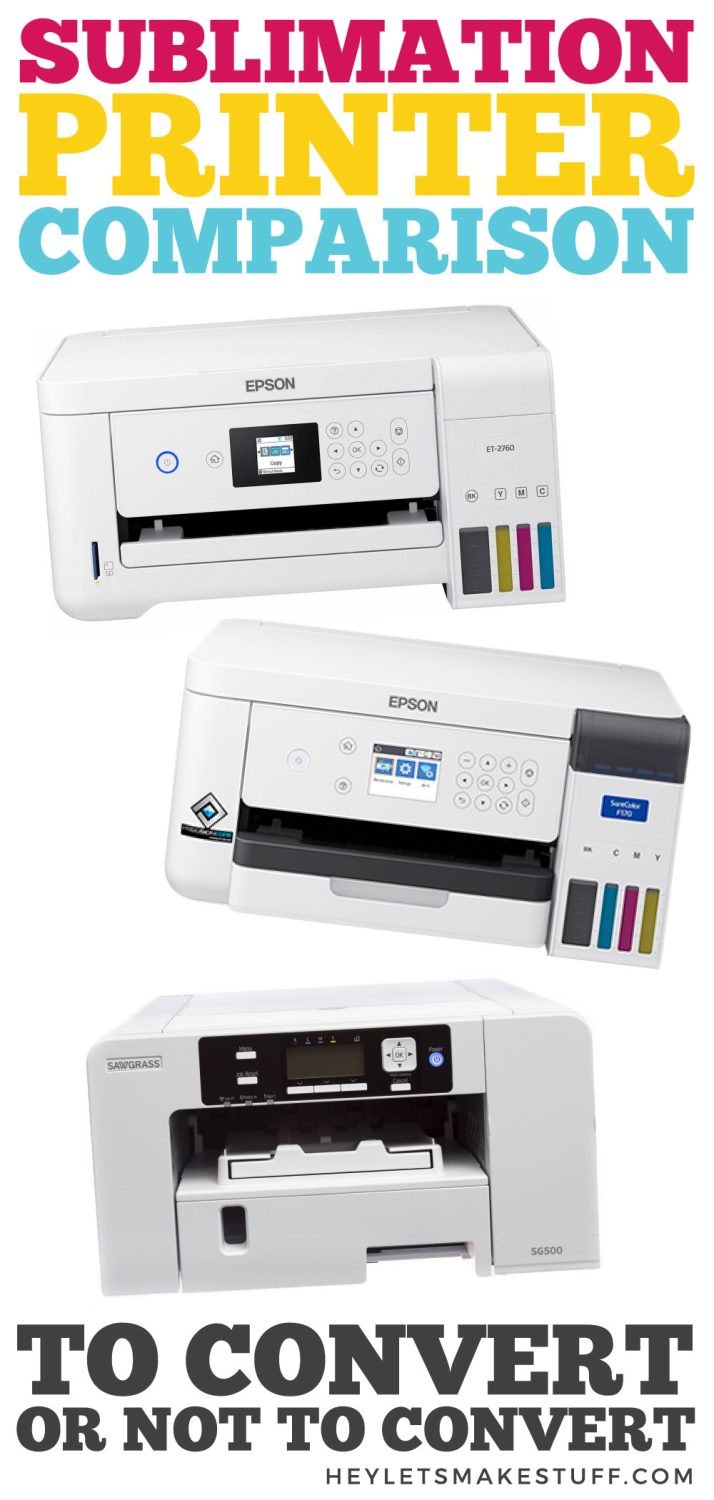
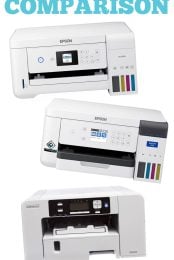


Comments & Reviews
Mike says
So Epson says that the ink is only good for 6 months after installation in the printer and after that “print quality may degrade”. What has you experience been – 140ml of ink is a HUGE amount for low volume users, I think that is about 5 or 600 pages and I would never do that much in 6 months ( I think :). ). So would not want to be flushing out a bunch of ink (not even sure how I would do that) every 6 months and spending another $100 to fill it back up. Just looking for some real world experiences. Other than that the F170 seems like a really good value.
thanks!
Crystal Summers says
Hi Mike,
Honestly, I think everyone’s experience will differ here, but I have never felt the quality of my sublimation ink was impacted by age. I’ve definitely had ink over 6 months. I think it also depends on whether you are printing to sell items or just for fun. Again, everyone has different standards of what is acceptable for them. The main thing you’ll want to consider is how often you are printing. Sublimation ink will dry up if it sits idle too long. If you aren’t printing often, you’ll want to perform printer maintenance by cleaning the print head to keep everything clog-free. I hope this helps!
Happy crafting,
Crystal, HLMS Community Manager